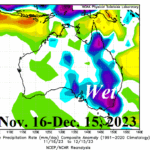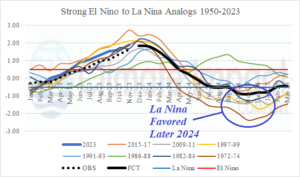El Nino to La Nina in 2024, What to Expect for DEC/JAN/FEB 2024-25
12/12/2023, 6:44 am EST
Why Is Eastern Australia Wet During The 2023 El Nino?
12/17/2023, 12:17 pm EST
Fig. 1: Tracking annual multivariate ENSO index in the weather satellite derived data era.
Discussion: One way to learn about the dynamics of meteorology and climate is attendance of the Annual Climate Diagnostics Workshop presented by NOAA/CPC. Attending several of those workshops around 20 years ago, climate scientists emphasized a transition taking place whereas the decadal ENSO cycle which lasts (usually) 2 to 4 decades had changed to the cool phase. Although El Nino is occurring now, the frequency of La Nina events has certainly outweighed warm ENSO since the late 1990’s. The last warm cycle lasted from the middle 1960’s to middle 1990’s. One would expect a long-term ENSO phase change to more persistent El Nino events to occur sometime within the next 10 years. Climate Impact Company always advises meteorologists and industry analysts to evaluate/weight their analog years toward the proper long-term ENSO phase.
The multivariate ENSO index (MEI) for OCT/NOV 2023 was +0.8 which is the first El Nino-like value for the 2023-24 El Nino despite oceanic El Nino onset last June. An atmospheric El Nino, as defined by MEI, has not lagged this far behind oceanic El Nino in the modern-day record. Many reasons are speculated as to why this is happening such as the unique warming of the global oceans and the weaker tropical convection (and location) given an El Nino. An exceptionally strong positive phase of the Indian Ocean dipole (+IOD) may have contributed. We await formal published research on this subject for an explanation.
The unusual large spread between MEI and Nino34 SSTA should have implications for where ENSO is going in 2024. In all honesty, we’re not sure where. Today’s NCEP CFS V2 has an ensemble member projecting a Nino34 SSTA of -2.4C for April. What drove that model to produce that wild forecast? At the same time, Australia Bureau of Meteorology indicates a +1.7C for the Nino34 SSTA. The forecast solutions for Q2/2024 range from lingering strong El Nino to emerging intense La Nina. According to the International Research Institute for Climate and Society who collect all dynamic and statistical Nino34 SSTA forecasts, the most likely ENSO scenario for ENSO in 2024 is neutral phase by mid-year (Fig. 2). The Climate Impact Company (CIC) constructed analog forecast reveals a 5-in-7 chance of La Nina in 2024 with a 2-in-7 chance of a strong La Nina (Fig. 3).
The bottom line? There is a likelihood for a complete reversal in global climate patterns from what they are now for later 2024. The potential for a long-term change in the ENSO cycle is emerging on the horizon.

Fig. 2: A collection of all dynamic and statistical Nino34 SSTA forecasts to project ENSO phase in 2024.

Fig. 3: The Climate Impact Company constructed analog Nno34 SSTA forecast through March 2025.
